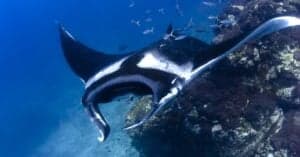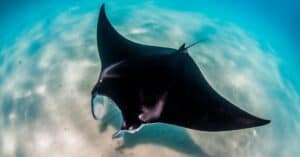Manta rays are the world’s largest rays, with the biggest species measuring 23 feet on average. They are gentle, intelligent creatures that inhabit warm waters, but what do manta rays eat, and does anything dare try and eat enormous manta rays? Let’s discover the manta diet and much more.
What Is a Manta Ray?
Before we start answering the question of what manta rays eat, it’s worth finding out what these incredible creatures are. That will help shed light on their diet.
Manta rays are large ray fish in the Myliobatidae family and the Mobula genus. There are two species of manta ray.
- The smallest reef manta ray (Manta alfredi) reaches 18 feet.
- The giant oceanic manta ray (Manta birostris) averages 23 feet but can reach up to 30 feet.
There’s no arguing that’s an epic fish size!
Manta rays can weigh a whopping 5,000 lbs. They have triangular bodies and huge, wide, flat “wings,” which are actually pectoral fins. Two lobes called cephalic horns extend from their head, which has inspired the alternate name “devil fish.”
The name manta is Spanish for ‘blanket’ or ‘shawl.’ It refers to their thin but up to 30 feet wide wingspan.
Manta rays only give birth every two or three years to just one baby, which is called a pup. They can live up to 60 years, but commercial fishing often kills them beforehand.
Manta rays eat in an unusual way. They hold their cephalic horns in a circle and open their mouths wide. Their horns funnel a channel of water towards their mouths, which filters prey across the gill plate rows that line their mouths.
The prey is ingested, and the water is expelled! Fish that feed this way are called filter feeders. Whale sharks and baleen whales eat the same way.
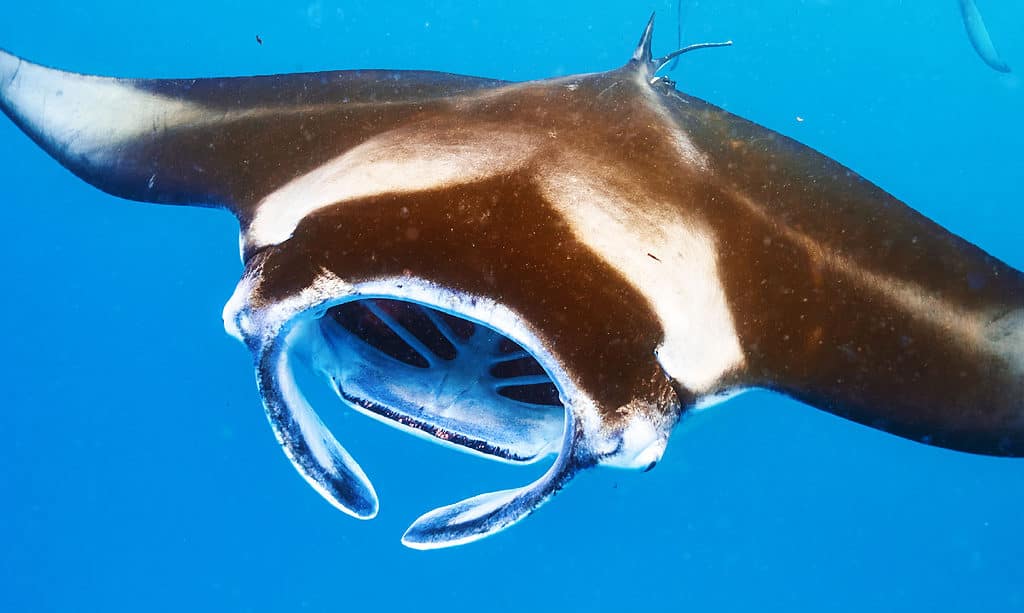
In order to capture their prey, manta rays form a funneling “O” shape with their cephalic horns and open wide.
©haveseen/Shutterstock.com
Manta Ray Diet
Now we know how a manta ray eats, it’s easier to understand what a manta ray eats.
Manta rays primarily eat plankton organisms, including copepods, mysids, and euphausiids, but fish eggs, small fish, whelks, crustaceans, bivalves, and shrimp get trapped into their feeding funnel too.
To get the most out of their filter funnel, manta rays perform acrobatics, barrel rolling, and somersaulting to maximize their intake. The largest manta rays sometimes filter feed on octopus and hermit crabs too, whatever meaty creatures are sucked into their mouth funnels. A manta ray eats around 12% of its body weight in plankton every week.
Experts think manta rays are essential for ocean ecosystems because they regulate plankton levels and recycle nutrients between the ocean floor and the surface water.
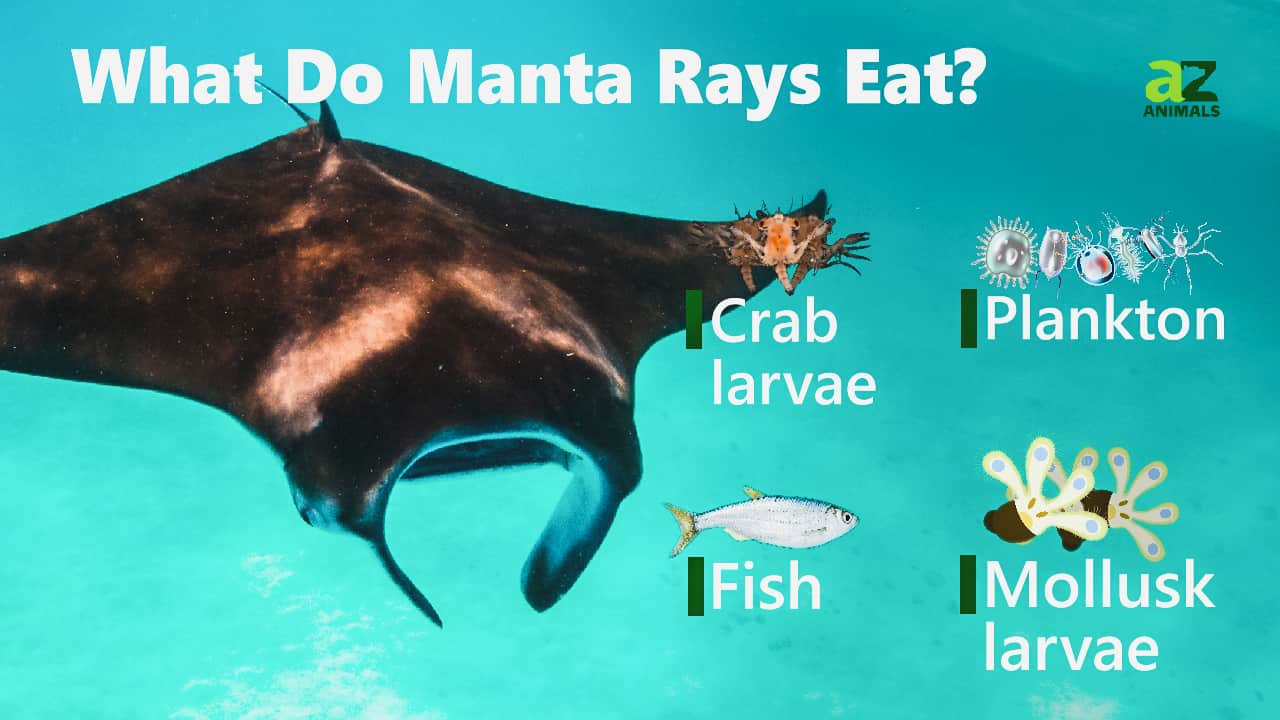
Is a Manta Ray a Clever Fish?
Yes, manta rays are clever fish. They have the largest brain-to-size ratio of all fish, which puts them on an intelligence level with dolphins and primates.
Manta rays pass the mirror test. A study suggests manta rays are self-aware because when presented with a mirror, the test subjects did not act as if they were encountering another fish. Instead, they flapped and circled in the same way apes responded to mirrors. Researchers believe this behavior tested reflection movements. You can read about it here in the Journal of Ethology.
Are Manta Rays the Same as Sting Rays?
No, manta rays are not the same animal as sting rays. They are different species. Manta rays evolved from sting rays, but they don’t live on the ocean floor, and they lack a sting ray’s barbed tail. Mantas are also much bigger. Their potential 30-foot wingspan dwarfs a stingray’s six-foot span.
An easy way to tell them apart is their undersides. Sting rays look like they’re smiling, but manta rays look grumpy.
Where Do They Live?
Manta rays live in warm tropical, subtropical, and temperate waters. They are migratory and seasonal visitors to warm coastlines, oceanic islands, and offshore pinnacles. They migrate following plankton, so tidal patterns that affect plankton movements carry them along.
Giant oceanic manta rays roam all over the world, but reef mantas tend to stay near Indo-Pacific reef lines. Reef mantas head to the reefs’ “cleaning stations” frequently so small fish can clean parasites from their skin.
Ecuador is home to the largest manta ray population, but it’s still rare for divers and snorkelers to encounter them. Those that do consider themselves very lucky.
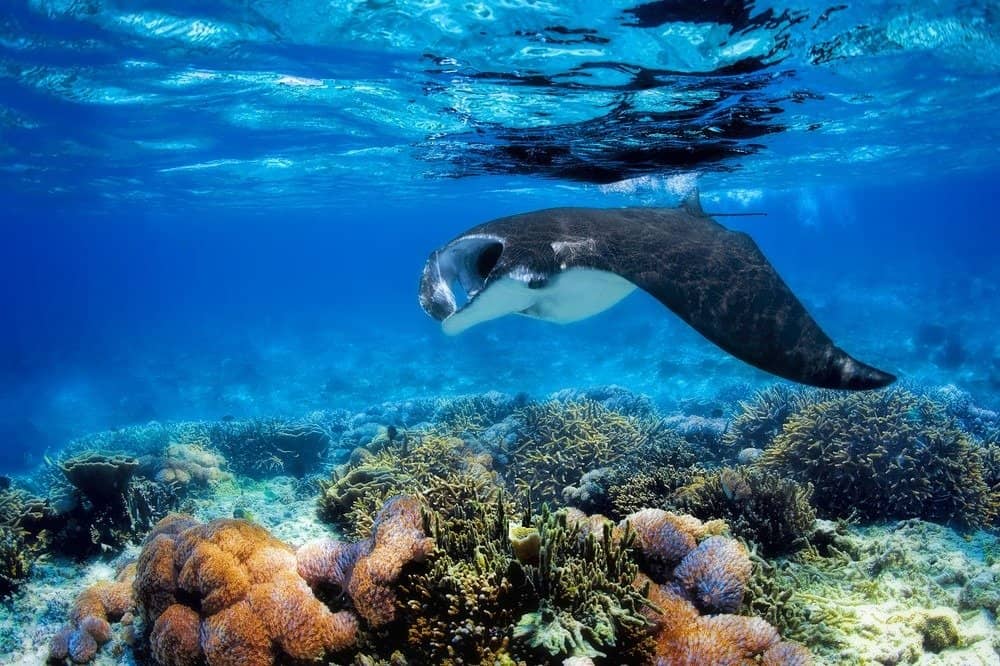
Manta ray filter feeding above a coral reef in the blue Komodo waters.
©Kjersti Joergensen/Shutterstock.com
Are Manta Rays Friendly?
Manta rays are friendly to humans. Despite their enormous size, they pose little threat to us. They lack a stinger, and due to their filter-feeding habit, they lack dangerous teeth. There is the possibility that a startled manta ray could crash into a diver and cause injuries, but this would be accidental, not an attack.
Because they are not aggressive, manta rays are called the “gentle giants of the sea.”
Is a Manta Ray a Fish?
Yes, manta rays are fish. They are elasmobranchs and closely related to sharks. However, for a very long time, experts thought they were marine mammals called cetaceans.
Manta rays have been spotted flying! Of course, this is not flying in the way a bird flies, but breaching from the water and falling back down. Experts don’t know why manta rays breach, but suggestions include evading predators, communicating, removing parasites, or simply because they enjoy it.
Do They Die if They Stop Moving?
Manta rays are perpetual motion fish, which means they never stop swimming. If they stopped, they would not be able to breathe. Manta rays need constant oxygen moving over their gills, so experts aren’t sure if they sleep or not!
Manta Ray Predators
Very few predators take adult manta rays because they are so large, but natural predators include orcas and large sharks. Manta pups are at more risk than fully-grown mantas.
Manta rays’ most troublesome predators are humans. Even though they are protected, manta rays are caught in nets as by-catch and specifically hunted as fish delicacies.
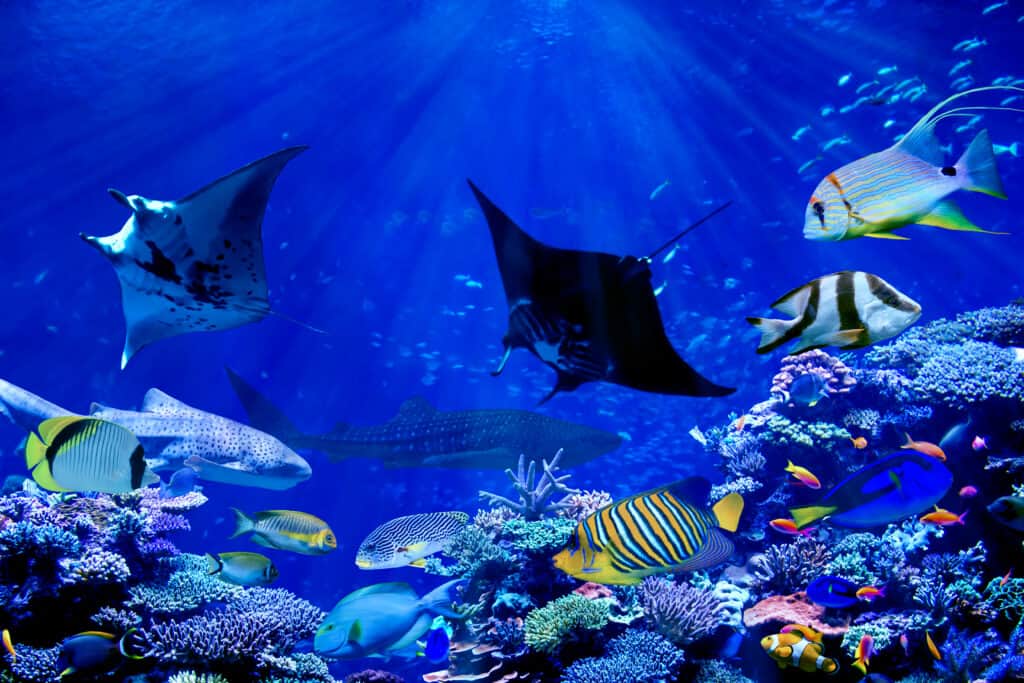
Manta rays dance with tropical marine fish, such as whale sharks and
angelfish
, in beautiful coral reefs.
©chonlasub woravichan/Shutterstock.com
The Largest Manta Ray Ever
According to the Guinness World Records, the largest ever recorded manta ray reached 30 feet. This record stands from 1920. The heaviest manta ray ever recorded was caught in 1933. It weighed 5,000 pounds.
Are Manta Rays Endangered?
Yes, manta rays are under threat from human activity.
The giant oceanic manta ray was classed as endangered by the IUCN in December 2020, and the reef manta is classed as vulnerable with decreasing numbers.
Many countries have placed fishing bans on manta rays, and they are protected in international waters by the Convention on Migratory Species.
See Manta Rays in the Wild
Some places you can see manta rays in the wild are Ari and Baa Atolls in the Maldives, Costa Rica, Tofu in Mozambique, and Isla de la Plata in Ecuador.
Hawaii’s Big Island has three night-time manta ray viewing sites where they are often spotted feeding, and Maui’s Olowalu Reef is close to a manta ray cleaning station.
Manta Rays in Captivity
Manta rays are difficult captive fish due to their epic size and need for perpetual motion. This means a very large tank is necessary, and only a few facilities are able to provide such a large space.
Here are four places able to keep captive manta rays:
- Georgia Aquarium, Atlanta
- Atlantis Resort, the Bahamas
- Okinawa Churaumi Aquarium, Japan
- S.E.A. Aquarium, Singapore
Manta Rays: What Do They Eat?
Let’s refresh on our question, “What do manta rays eat?”
Manta rays mostly eat plankton, including krill, mysids, copepods, and euphausiids, but they also consume small fish, crustaceans, bivalves, fish eggs, and whelks. The largest giant manta rays eat octopus and hermit crabs, too.
They manage to eat such a variety of ocean life because they are filter feeders.
In order to capture their prey, manta rays form a funneling “O” shape with their cephalic horns and open wide. Water rushes into their mouths, carrying all kinds of ocean life.
Captured creatures filter over a manta ray’s gill plates. Eventually, water floats away, leaving the manta ray with a pick and mix of ocean delights for lunch.
They really are incredible creatures, and there’s still much to learn about their mysterious ways.
The photo featured at the top of this post is © Aaronejbull87/Shutterstock.com
Thank you for reading! Have some feedback for us? Contact the AZ Animals editorial team.




